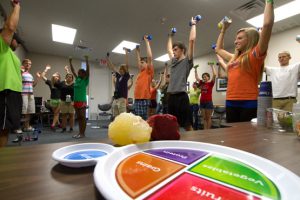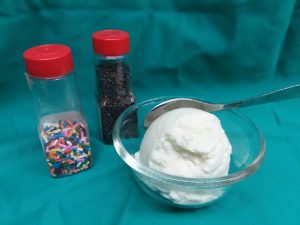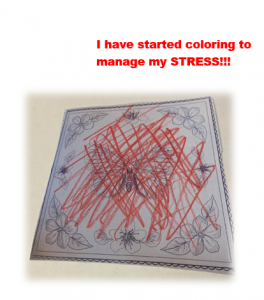
by Dorothy C. Lee | Jul 21, 2019
Eating healthy is not something that just happens by going on a particular diet. In fact, the best kind of diet is where the right choices are made, and it becomes a way of life. Sometimes we need to know some ways to change the bad habits we have developed. There is no ‘quick fix’.

Tune Up Your Lifestyle
Photo Source: UF/IFAS
With today’s fast-paced lifestyles sometimes we feel we don’t have the time to do the things we know we should. For instance, to get more exercise, do things like park a distance from the store when you go shopping, walk up and down the stairs instead of taking the elevator, walk to lunch, or even turn up the speed on regular activities you perform around the house.
When grocery shopping choose foods from the basic food groups (fruits, vegetables, whole grains, lean protein, and reduced-fat dairy products) to round out a healthy meal plan.
Convenience foods are a part of today’s lifestyle, but they often lack nutritional quality, texture, and flavor. Preparing foods at home can be healthy and economical. You can boost nutrition and flavor by adding fresh herbs, spices, and aromatic vegetables to the meal menu.
Foods and beverages high in sugar add empty calories to the diet and contribute no nutritional value. Read labels to determine the amount of added sugar in food products. Choose lower calorie beverages.
Experiment with new food items. Try adding different fruits, vegetables, or grains to your diet. For example, try tropical fruits such as mango, guava, papaya, or grains as quinoa, barley, or millet, to add vitamins, minerals and fiber to the diet.
Before you go out to eat, don’t starve yourself. Drink water before the meal to avoid overeating or eat a snack before dinner and you won’t be tempted to overeat.
When socializing don’t meet at eating places. When you do dine out, cut out fried main dishes or ones with heavy sauces and gravies. Eat smaller portions and don’t go back for seconds. Order low-fat foods when possible. However, keep in mind that you too need to allow for indulgence along the way.
Be active! Physical activity has health benefits. Being physically active not only burns calories, it aids in physical strength, and cardiovascular health. U.S. Dietary Guidelines recommend being physically active at least 150 minutes a week for adults. (https://health.gov/dietaryguidelines/).
Chances are, along with a healthy diet and regular physical activity, your tune up will result in living a healthy lifestyle.
https://www.freshfromflorida.com/Consumer-Resources/Buy-Fresh-From-Florida/Tropical-Fruit
https://www.tropicalfruitgrowers.com/
For further information, contact:
Dorothy C. Lee, C.F.C.S.
UF/IFAS Extension Escambia County
3740 Stefani Road
Cantonment, FL 32533-7792
(850) 475-5230
dclee@ufl.edu

by Angela Hinkle | Jul 18, 2019
Cold and refreshing on a hot summer day. Official by presidential proclamation. It practically saved my life once. Behold – The Power of Ice Cream.
HISTORY
Some say the Chinese invented ice cream in the first century. Roman emperors are also credited with flavoring ice gathered from mountain tops. Still others say ice cream found its start in the areas of Iran or Ancient Greece. Regardless of its origins, ice cream was often only available to royalty who could afford the resources to make it. Once refrigeration/freezing became affordable, the popularity and availability of ice cream rose considerably. So now, most of us – royalty or not – can enjoy the Power of Ice Cream all year long.
THE 411
- Ice Cream is made with greater than 10% milkfat.
- Gelato is generally made up of 7%-8% fat.
- Soft serve has more air mixed in.
- Frozen Yogurt is usually lower in fat and is often available soft-serve style.
- Sherbet freezes a combination of fruit juice with milk, cream, egg white, or gelatin.
THE 911
Picture it. Moving day. One of the hottest, most humid days of the year. The kind of day that you feel like you’re walking around in really warm soup. Though I’m staying hydrated, after about four hours in, it hits me. I go into a fog and literally start to go down to the ground. Luckily, my dad is pretty quick on his feet for a big Sicilian man. He puts me in the shade and says, “Don’t move!’ To this day, I don’t know how he did it so fast, but within two minutes, he got me the best cold ice cream dessert ever. The world was quickly righted as was I. Though this is NOT normal emergency protocol, it’s my miracle ice cream story and I’m sticking to it.
COOL TIDBITS

A cool and refreshing sweet treat
Photo Source: Angela Hinkle
- The United States leads the way in ice cream consumption, eating or licking or drinking about 48 pints or 23 pounds a year.
- President Ronald Reagan declared July National Ice Cream Month. The third Sunday in July, this year July 21st, is National Ice Cream Day.
- Though boasting 31 flavors, Baskin Robbins’ most popular flavor is vanilla.
- Because acquiring vanilla was so difficult before the mid-1800s, vanilla ice cream was considered quite an exotic treat.
- Sometimes, because nerve endings on the roof of your mouth suddenly get cold from eating ice cream, your brain tells the blood vessels, “Contract!” When they go back to their normal size, blood rushes back in. And ooh, “ice cream headache.” One recommendation to prevent this “brain freeze” is to eat slowly. And a recommendation to stop it is to put your tongue up to the roof of your mouth. Nothing guaranteed – so good luck.
- 15%-20% of Americans say they eat ice cream in bed. For more interesting ice cream trivia, visit foodreference.com
BENEFITS
Though not a particularly nutrient dense food, ice cream does have some health benefits. The area of your brain called the orbitofrontal cortex – or pleasure center – is activated when people are happy. Eating ice cream has been identified with having an immediate “happy” effect on the brain. There is also calcium in ice cream, which is good for building strong bones and teeth. Question – should all your daily calcium come from ice cream? Answer – Um, No. Try to choose more calcium-rich foods that are lower in fat and sugar.
So, in moderation of course, enjoy the Power of Ice Cream!

Cold, Delicious, and so many flavors! Photo source: Lyndsey B.
See Below for two healthier ice cream options. Yum!
MyPlate Sundae
This recipe includes all five food groups.
Layer in a clear glass bowl, mug, or cup so you can see all the colorful layers.
- Dairy – Gelato or frozen yogurt – your choice of flavor
- Vegetable – Frozen sweetened rhubarb or cooked, mashed, and cooled sweet potato
- Fruit – Most any berry works great
- Grain – granola
- Protein – Sprinkle on your favorite nuts
Cool and Creamy Calcium Dreamy
Serves 3
Items needed
1 – gallon heavy-duty ziptop bag
1 – quart heavy-duty ziptop bag
rock salt
ice
Procedure – In the 1 quart bag add the following:
¼ cup pasteurized liquid eggs
1 cup fat-free milk
1 cup fat-free half and half
½ cup sugar
1 teaspoon vanilla flavoring
Zip the top closed. Put the 1-quart bag inside the gallon bag. Pack the gallon bag with ice and ¾ cup of rock salt. Close the top. Work the bag back and forth – rolling over and over or tossing back and forth for 15 minutes. It may help to have potholders or a dish towel to hold the bag, as it will get very cold. Drain the water off and stir your cool and creamy calcium dreamy. Repack the gallon bag with ice and rock salt and roll or toss for five more minutes.
Serve immediately with fresh local fruits and nuts. Enjoy!
For more about the dairy food group see https://www.choosemyplate.gov/dairy

by Ginny Hinton | Jul 5, 2019
Summer has hit the Florida Panhandle with a vengeance this year! If you’re out in the heat it’s especially important to make sure to keep your body well-hydrated. After all, water is the single largest component of our body, and it’s essential for life.
Recommendations for how much to drink vary depending on several factors including your age, how active you are, how hot it is outside, what you’re wearing, and if you have certain medical conditions. A pretty good “ballpark” from the Institute of Medicine Food & Nutrition Board (IOMB) is to drink around 3 quarts of water a day for women and around 4 quarts for men. It’s important to start hydrating even before your feet hit the floor in the morning, because your body has been losing fluid while you slept. And if you can go more than 4 hours during the day without taking a bathroom break, you’re probably already dehydrated.

Water: Drink Up!
Photo Source: Ginny Hinton
Why worry about dehydration? In addition to making you more at risk of overheating, dehydration can affect a host of different organs and functions in your body. For example:
- Dehydration makes it harder for kidneys to flush toxins (poison) from your system, creating an infection-friendly environment.
- When you’re dehydrated, your blood becomes thicker and your heart has to pump harder to move it through your veins. This can lead to higher blood pressure.
- Dehydrated skin loses its elasticity and looks dry and flaky. Your sweat becomes more concentrated, making it harder for you to sweat as much as you need.
- Dehydrated joints are more brittle and more likely to become inflamed or damaged.
- When your body is low on water, it pulls too much liquid from the stool to use for other functions. That can cause constipation, in addition to inflammation throughout your body.
- Moist mucus membranes in the nose protect you from airborne allergens. Dehydration can dry them out and make you more vulnerable to irritating allergies.
- Dehydration makes you have less energy, and it also affects your mood and concentration. There’s a documented link between stress and dehydration.
The good news is that it’s easier to stay hydrated than you think. Water is a great way to hydrate, but it’s far from the only option. Watch the sugar and caffeine content when choosing other beverages, but milk, fruit juice, coffee and tea can all help you stay hydrated. The current guidelines to maximize the benefits and minimize the risks of caffeine intake are to drink no more than 1/3 to 4 cups of coffee per day (depending on the caffeine content) and 1 to 8 cups a day for tea. You can cut the sugar content but still have a tasty beverage by mixing half sweet tea with half unsweet, by mixing fruit juice with water, and by drinking flavored carbonated water with a splash of fruit juice to substitute for soda. Even food can help you stay hydrated! Watermelon, for example, is 90% water. Citrus fruits have a high water content as well, and vegetables like tomatoes, cucumbers and lettuce pack a powerful hydration punch.
As you get out and enjoy Florida’s sunny summer weather, just be sure to keep hydration in mind. Your body will thank you for it!

by Judy Corbus | Jul 5, 2019

Visit places close to home for a vacation that won’t break the budget. (Photo source: UF/IFAS)
“Summer” and “vacation” seem to go hand-in-hand, as school is out and schedules are a little more laid back. Now that summer is here, you may be making plans for a getaway to your favorite spot. Perhaps, you are saving up for that dream trip next summer but you’d still like to take a break and have some fun this year. How can your family and you enjoy yourselves without breaking the bank? The answer might be right in your own backyard!
- Plan a staycation. Rather than traveling out of the area, use your home as base and plan some fun activities – family game time, camping out in the backyard and making s’mores, or running through the sprinklers and having a water balloon fight. Or just relax with a good book and a glass of lemonade or catch a few zzzs under a tree. The key is to turn off the devices, forget about work, and not worry about projects around the house – they will be there after you “return.”
- Plan day trips. These can be a part of your staycation, too. If you live fairly close to the beach, pack the car and head out early to enjoy the surf before temperatures rise. Make a day of it by enjoying the sunset before heading home. State parks also offer hiking and biking trails, boating and canoeing, swimming, playgrounds, picnic areas, and other fun activities. Florida boasts of 175 state parks, trails, and historic sites around the state so your next adventure may be just a short drive away. Check out https://www.floridastateparks.org/ for a park near you.
- Check out local events. Libraries and museums often feature special exhibits for free or a nominal charge. Several years ago, I visited a traveling exhibit about the Titanic at an arts center an easy drive from home. It made for an enjoyable and educational afternoon! Contact your local library or museum for a schedule of summer program offerings.
- Take part in a service project. A number of families are opting to use some of their vacation time to help others in need in their communities – projects include yard work, painting, basic home repairs, assisting with a food pantry/clothes closet, and serving meals to the homeless. These projects may be sponsored by a community service organization or church. During this past spring, local media outlets reported on several groups of college students representing campus ministries, fraternities, and other organizations who volunteered their Spring Break time to assist with Hurricane Michael clean-up and recovery. Participating in a service project as a family can be a meaningful way to give back to the community and make a difference locally. Contact your place of worship or local service organizations for opportunities in your area.
This summer, “recharge” without a super charge to your wallet!
Source: https://www.daveramsey.com/blog/i-need-a-staycation

by Laurie Osgood | Jun 7, 2019
 What is Stress Anyway?
What is Stress Anyway?
The traffic is awful, a report is due, the laundry is piling up, and the kids are fighting. Life is full of stress! According to the National Institute of Mental Health, stress is how the brain and body respond to any physical, mental, and/or emotional demand. Not all stress is bad. For example, stress can help motivate us to get things done. When faced with a threat or stressful event, our bodies produce hormones such as epinephrine, which can cause a temporary rise in our heart rate and blood pressure. Chronic, un-managed stress can cause long-term symptoms including headaches, high blood pressure and even problems sleeping.
Identify the Sources of Stress in Your Life
Feeling stressed is normal, but some people cope with stress better than others. Our thoughts, lifestyle and emotions can affect how much stress we endure. We must identify the causes of our stress before we can begin to manage them. Although the causes of stress are similar for both men and women, it is how we recognize and manage our stress that makes us different.
Common Causes of Stress:
• Work or unemployment
• Money, finances
• Drug or alcohol abuse
• Family breakdown
• Health issues
• Major life changes
What are the Symptoms of Stress?
Our bodies automatically respond to stressors in our lives. However, constant and uncontrolled stress can lead to serious physical and mental consequences. No matter how stressful your life seems, we must recognize the warning signs of stress and take action.
Watch out for the following warning signs:
• Feeling tired, not sleeping properly
• Loss of concentration and an inability to complete projects
• Irritability, low self-esteem or mood swings
• Feeling tense or anxious
• Feeling unmotivated
• Withdrawing from family and friends
• Excessive drinking and/or drug use
• Physical signs such as headaches, chest pains, high blood pressure, digestive problems or aches and pains
Men and Woman Handle Stress Differently
How stress affects you may depend upon your gender. Men and women recognize and react to stress in different ways, both mentally and physically.
When feeling stressed, women reach out to friends and family. They seek support to lower their stress and find a solution to their challenges. By talking about their emotions, women are able to process their feelings and share the pressure of their situation.
When men experience stressful situations, they are likely to hide their feelings or change the subject to escape a stressful situation. Men find it hard to talk about their feelings or ask for help when faced with pressures from their job, family issues or money worries. Men prefer to play sports or listen to music to manage stress.
Stress Reduction Strategies for Men and Women
Stress is a normal part of life, but chronic stress can be bad for our health. Stress management means taking control of your thoughts, emotions, and lifestyle. Making simple changes in your life such as maintaining a network of close friends, exercising, eating a healthy diet, and getting enough sleep can help reduce your overall stress.
Resources:
The American Psychological Association: https://www.apa.org/news/press/releases/stress/2010/gender-stress
The National Institute of Mental Health: https://www.nimh.nih.gov/health/publications/stress/index.shtml
The Electronic Data Information Source of UF/IFAS Extension. EDIS: https://edis.ifas.ufl.edu/pdffiles/FY/FY51700.pdf
To learn more about how to cope with stress, contact Laurie Osgood, Family and Consumer Sciences Agent at the UF/IFAS Extension Office in Gadsden County (850) 875-7255 or Osgoodlb@ufl.edu


by Amy Mullins, PhD, RDN | May 31, 2019

Stay hydrated this summer.
Nothing is more refreshing on a hot summer day than an ice-cold glass of water! Water is an essential component to good health. In fact, it makes up 60% of your body’s weight and is involved in various metabolic processes throughout your body. Without it, you could not survive. As summer approaches, it is important to be mindful of the increasing temperatures outside since the chances for dehydration are much greater than other times of the year – especially if you are planning to spend a lot of time outdoors.
Dehydration happens when your body lacks enough water to carry out normal processes. It often occurs when you are expending more water (usually through sweat & exercise) than you are consuming, and is accelerated in warm humid climates. Dehydration is no joke, and can lead to serious medical complications such as heat stroke, heat stress, and even death. Common signs and symptoms that may indicate you are dehydrated include fatigue, headache, dry mouth, little to no urination, constipation, vomiting, muscle-weakness, dizziness, and lightheadedness. Most susceptible to heat stress and complications from dehydration include infants, older adults (65 & up), people who are overweight, and people who are excessive sweaters during physical activity. If you fall into any of those categories, try to be mindful about how much fluid you are consuming throughout the day.
How can you prevent dehydration?
While many people think they may be drinking enough, that is often not the case. Your own thirst mechanism isn’t always the best gauge to make sure you are properly hydrated. According to the National Academy of Medicine, women should consume an average of 9 ½ cups of water per day and men should be consuming 12 cups. For older adults over the age of 70, the rule of thumb is about 7 cups per day. That includes all fluids from water, coffee, and juices.
Keep in mind that needs may be different for each of us. One simple way to check your hydration status is to look at the color of your urine. If the color of your urine is a light lemonade color, you are in the clear! However, if your urine color is a dark orange, you need to start drinking some fluids to get back to a hydrated state to avoid any health complications.
Additional ways to reach your fluid intake without refilling your water bottle
Did you know water makes up the largest component of many of the foods we eat? By adding some more fruits and vegetables to your diet such as watermelon, strawberries, melons, oranges, broccoli, bell peppers, and lettuces – you are not only increasing your fluid intake but getting your necessary vitamins and minerals as well! According to the Dietary Guidelines for Americans, people should be consuming an average of 2 cups of fruits and vegetables per day.
Other factors that can influence your hydration status
Alcohol – Alcohol acts as a diuretic – meaning it turns down a hormone called antidiuretic hormone (ADH) which tells your kidneys to absorb/retain fluids. In other words, drinking a lot of alcohol will make you expel more fluids from your body. Make sure to drink extra water while enjoying alcoholic beverages to avoid becoming dehydrated.
Diet – Consuming a high-sodium diet is another cause of dehydration. Sodium is necessary in our diets, but only in very small amounts. When we consume excessive amounts of sodium, this disrupts the body’s filtration system and the kidneys begin holding onto more and more water. This leads to dehydration, bloating, edema, hypertension, and cardiovascular stress. Drinking extra water can help bring things back into balance and re-hydrate your thirsty cells!
Older Age – As we get older, thirst sensations decrease and risk for dehydration increases since older adults do not feel the need to drink as much. Additionally, many medications can influence fluid needs in the body.
Caffeine – Contrary to popular belief, caffeine does not dehydrate you. When you drink coffee, or other caffeinated beverages you are also consuming fluids. High fluid consumption leads to higher frequency of urination.
Learn to LOVE Water
Water by itself can definitely get old if it isn’t your beverage of choice. There are plenty of ways to add flavor and sweetness to your drinks without packing in tons of extra calories and sugar. Fruit infusions are a very simple way to make a boring beverage much more delicious. Try some of these delightful, thirst-quenching recipes!
Raspberry Orange Mint
- Water
- 1 cup raspberries
- 1 orange sliced up
- Mint leaves
Lemon Lime Thyme
- Water
- 1 lemon sliced
- 1 lime sliced
- 1 large sprig of fresh thyme
Blueberry Lemon Mint
- Water
- 1 cup blueberries
- 1 lemon sliced














